Hao Su
Member, IEEE
FreeArt3D: Training-Free Articulated Object Generation using 3D Diffusion
Oct 29, 2025Abstract:Articulated 3D objects are central to many applications in robotics, AR/VR, and animation. Recent approaches to modeling such objects either rely on optimization-based reconstruction pipelines that require dense-view supervision or on feed-forward generative models that produce coarse geometric approximations and often overlook surface texture. In contrast, open-world 3D generation of static objects has achieved remarkable success, especially with the advent of native 3D diffusion models such as Trellis. However, extending these methods to articulated objects by training native 3D diffusion models poses significant challenges. In this work, we present FreeArt3D, a training-free framework for articulated 3D object generation. Instead of training a new model on limited articulated data, FreeArt3D repurposes a pre-trained static 3D diffusion model (e.g., Trellis) as a powerful shape prior. It extends Score Distillation Sampling (SDS) into the 3D-to-4D domain by treating articulation as an additional generative dimension. Given a few images captured in different articulation states, FreeArt3D jointly optimizes the object's geometry, texture, and articulation parameters without requiring task-specific training or access to large-scale articulated datasets. Our method generates high-fidelity geometry and textures, accurately predicts underlying kinematic structures, and generalizes well across diverse object categories. Despite following a per-instance optimization paradigm, FreeArt3D completes in minutes and significantly outperforms prior state-of-the-art approaches in both quality and versatility.
ORIC: Benchmarking Object Recognition in Incongruous Context for Large Vision-Language Models
Sep 19, 2025Abstract:Large Vision-Language Models (LVLMs) have made significant strides in image caption, visual question answering, and robotics by integrating visual and textual information. However, they remain prone to errors in incongruous contexts, where objects appear unexpectedly or are absent when contextually expected. This leads to two key recognition failures: object misidentification and hallucination. To systematically examine this issue, we introduce the Object Recognition in Incongruous Context Benchmark (ORIC), a novel benchmark that evaluates LVLMs in scenarios where object-context relationships deviate from expectations. ORIC employs two key strategies: (1) LLM-guided sampling, which identifies objects that are present but contextually incongruous, and (2) CLIP-guided sampling, which detects plausible yet nonexistent objects that are likely to be hallucinated, thereby creating an incongruous context. Evaluating 18 LVLMs and two open-vocabulary detection models, our results reveal significant recognition gaps, underscoring the challenges posed by contextual incongruity. This work provides critical insights into LVLMs' limitations and encourages further research on context-aware object recognition.
FFT-Free PAPR Reduction Methods for OFDM Signals
Sep 17, 2025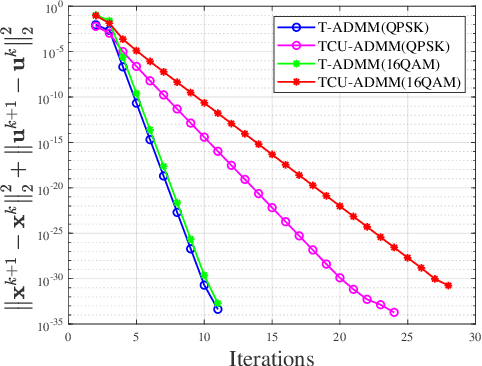


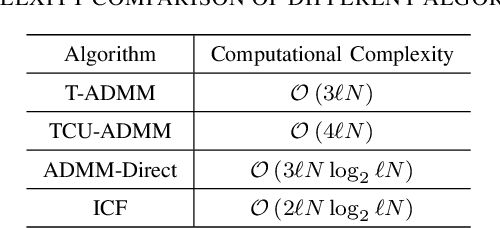
Abstract:In this paper, we propose two low-complexity peak to average power ratio(PAPR) reduction algorithms for orthogonal frequency division multiplexing(OFDM) signals. The main content is as follows: First, a non-convex optimization model is established by minimizing the signal distortion power. Then, a customized alternating direction method of multipliers(ADMM) algorithm is proposed to solve the problem, named time domain ADMM(T-ADMM) along with an improved version called T-ADMM with constrain update(TCU-ADMM). In the algorithms, all subproblems can be solved analytically, and each iteration has linear computational complexity. These algorithms circumvents the challenges posed by repeated fast Fourier transform(FFT) and inverse FFT(IFFT) operations in traditional PAPR reduction algorithms. Additionally, we prove that the T-ADMM algorithm is theoretically guaranteed convergent if proper parameter is chosen. Finally, simulation results demonstrate the effectiveness of the proposed methods.
LodeStar: Long-horizon Dexterity via Synthetic Data Augmentation from Human Demonstrations
Aug 24, 2025Abstract:Developing robotic systems capable of robustly executing long-horizon manipulation tasks with human-level dexterity is challenging, as such tasks require both physical dexterity and seamless sequencing of manipulation skills while robustly handling environment variations. While imitation learning offers a promising approach, acquiring comprehensive datasets is resource-intensive. In this work, we propose a learning framework and system LodeStar that automatically decomposes task demonstrations into semantically meaningful skills using off-the-shelf foundation models, and generates diverse synthetic demonstration datasets from a few human demos through reinforcement learning. These sim-augmented datasets enable robust skill training, with a Skill Routing Transformer (SRT) policy effectively chaining the learned skills together to execute complex long-horizon manipulation tasks. Experimental evaluations on three challenging real-world long-horizon dexterous manipulation tasks demonstrate that our approach significantly improves task performance and robustness compared to previous baselines. Videos are available at lodestar-robot.github.io.
MorphoCopter: Design, Modeling, and Control of a New Transformable Quad-Bi Copter
Jun 08, 2025Abstract:This paper presents a novel morphing quadrotor, named MorphoCopter, covering its design, modeling, control, and experimental tests. It features a unique single rotary joint that enables rapid transformation into an ultra-narrow profile. Although quadrotors have seen widespread adoption in applications such as cinematography, agriculture, and disaster management with increasingly sophisticated control systems, their hardware configurations have remained largely unchanged, limiting their capabilities in certain environments. Our design addresses this by enabling the hardware configuration to change on the fly when required. In standard flight mode, the MorphoCopter adopts an X configuration, functioning as a traditional quadcopter, but can quickly fold into a stacked bicopters arrangement or any configuration in between. Existing morphing designs often sacrifice controllability in compact configurations or rely on complex multi-joint systems. Moreover, our design achieves a greater width reduction than any existing solution. We develop a new inertia and control-action aware adaptive control system that maintains robust performance across all rotary-joint configurations. The prototype can reduce its width from 447 mm to 138 mm (nearly 70\% reduction) in just a few seconds. We validated the MorphoCopter through rigorous simulations and a comprehensive series of flight experiments, including robustness tests, trajectory tracking, and narrow-gap passing tests.
ManiTaskGen: A Comprehensive Task Generator for Benchmarking and Improving Vision-Language Agents on Embodied Decision-Making
May 27, 2025Abstract:Building embodied agents capable of accomplishing arbitrary tasks is a core objective towards achieving embodied artificial general intelligence (E-AGI). While recent work has advanced such general robot policies, their training and evaluation are often limited to tasks within specific scenes, involving restricted instructions and scenarios. Existing benchmarks also typically rely on manual annotation of limited tasks in a few scenes. We argue that exploring the full spectrum of feasible tasks within any given scene is crucial, as they provide both extensive benchmarks for evaluation and valuable resources for agent improvement. Towards this end, we introduce ManiTaskGen, a novel system that automatically generates comprehensive, diverse, feasible mobile manipulation tasks for any given scene. The generated tasks encompass both process-based, specific instructions (e.g., "move object from X to Y") and outcome-based, abstract instructions (e.g., "clear the table"). We apply ManiTaskGen to both simulated and real-world scenes, demonstrating the validity and diversity of the generated tasks. We then leverage these tasks to automatically construct benchmarks, thoroughly evaluating the embodied decision-making capabilities of agents built upon existing vision-language models (VLMs). Furthermore, we propose a simple yet effective method that utilizes ManiTaskGen tasks to enhance embodied decision-making. Overall, this work presents a universal task generation framework for arbitrary scenes, facilitating both benchmarking and improvement of embodied decision-making agents.
Towards Embodiment Scaling Laws in Robot Locomotion
May 09, 2025Abstract:Developing generalist agents that can operate across diverse tasks, environments, and physical embodiments is a grand challenge in robotics and artificial intelligence. In this work, we focus on the axis of embodiment and investigate embodiment scaling laws$\unicode{x2013}$the hypothesis that increasing the number of training embodiments improves generalization to unseen ones. Using robot locomotion as a test bed, we procedurally generate a dataset of $\sim$1,000 varied embodiments, spanning humanoids, quadrupeds, and hexapods, and train generalist policies capable of handling diverse observation and action spaces on random subsets. We find that increasing the number of training embodiments improves generalization to unseen ones, and scaling embodiments is more effective in enabling embodiment-level generalization than scaling data on small, fixed sets of embodiments. Notably, our best policy, trained on the full dataset, zero-shot transfers to novel embodiments in the real world, such as Unitree Go2 and H1. These results represent a step toward general embodied intelligence, with potential relevance to adaptive control for configurable robots, co-design of morphology and control, and beyond.
Coupled Distributional Random Expert Distillation for World Model Online Imitation Learning
May 04, 2025Abstract:Imitation Learning (IL) has achieved remarkable success across various domains, including robotics, autonomous driving, and healthcare, by enabling agents to learn complex behaviors from expert demonstrations. However, existing IL methods often face instability challenges, particularly when relying on adversarial reward or value formulations in world model frameworks. In this work, we propose a novel approach to online imitation learning that addresses these limitations through a reward model based on random network distillation (RND) for density estimation. Our reward model is built on the joint estimation of expert and behavioral distributions within the latent space of the world model. We evaluate our method across diverse benchmarks, including DMControl, Meta-World, and ManiSkill2, showcasing its ability to deliver stable performance and achieve expert-level results in both locomotion and manipulation tasks. Our approach demonstrates improved stability over adversarial methods while maintaining expert-level performance.
PARTFIELD: Learning 3D Feature Fields for Part Segmentation and Beyond
Apr 15, 2025Abstract:We propose PartField, a feedforward approach for learning part-based 3D features, which captures the general concept of parts and their hierarchy without relying on predefined templates or text-based names, and can be applied to open-world 3D shapes across various modalities. PartField requires only a 3D feedforward pass at inference time, significantly improving runtime and robustness compared to prior approaches. Our model is trained by distilling 2D and 3D part proposals from a mix of labeled datasets and image segmentations on large unsupervised datasets, via a contrastive learning formulation. It produces a continuous feature field which can be clustered to yield a hierarchical part decomposition. Comparisons show that PartField is up to 20% more accurate and often orders of magnitude faster than other recent class-agnostic part-segmentation methods. Beyond single-shape part decomposition, consistency in the learned field emerges across shapes, enabling tasks such as co-segmentation and correspondence, which we demonstrate in several applications of these general-purpose, hierarchical, and consistent 3D feature fields. Check our Webpage! https://research.nvidia.com/labs/toronto-ai/partfield-release/
Learning Adaptive Dexterous Grasping from Single Demonstrations
Mar 26, 2025
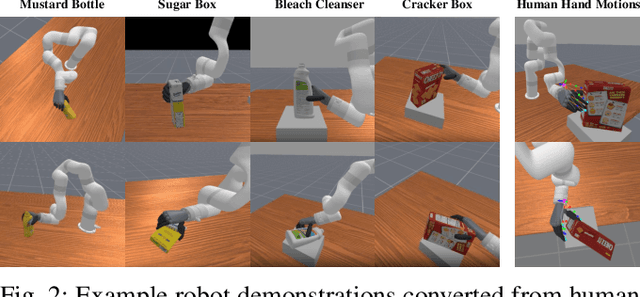
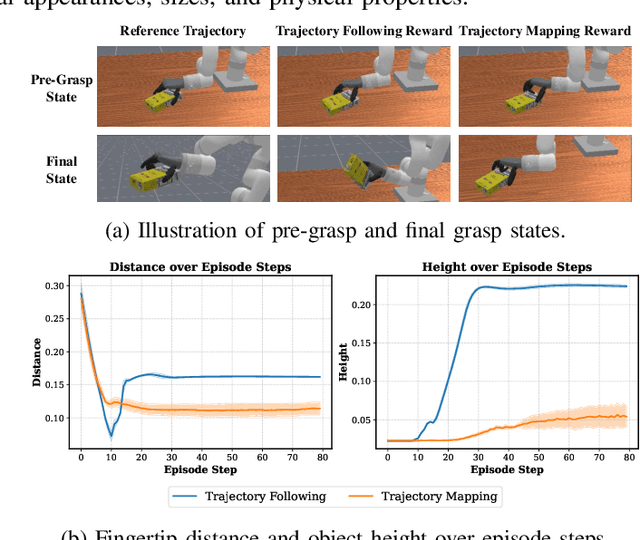
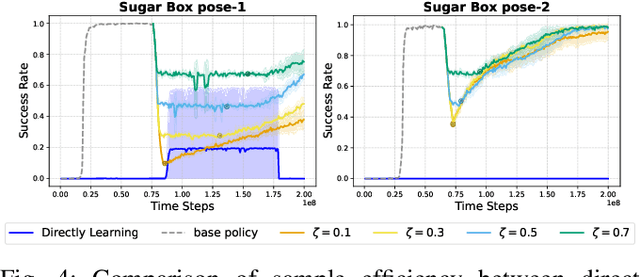
Abstract:How can robots learn dexterous grasping skills efficiently and apply them adaptively based on user instructions? This work tackles two key challenges: efficient skill acquisition from limited human demonstrations and context-driven skill selection. We introduce AdaDexGrasp, a framework that learns a library of grasping skills from a single human demonstration per skill and selects the most suitable one using a vision-language model (VLM). To improve sample efficiency, we propose a trajectory following reward that guides reinforcement learning (RL) toward states close to a human demonstration while allowing flexibility in exploration. To learn beyond the single demonstration, we employ curriculum learning, progressively increasing object pose variations to enhance robustness. At deployment, a VLM retrieves the appropriate skill based on user instructions, bridging low-level learned skills with high-level intent. We evaluate AdaDexGrasp in both simulation and real-world settings, showing that our approach significantly improves RL efficiency and enables learning human-like grasp strategies across varied object configurations. Finally, we demonstrate zero-shot transfer of our learned policies to a real-world PSYONIC Ability Hand, with a 90% success rate across objects, significantly outperforming the baseline.
 Add to Chrome
Add to Chrome Add to Firefox
Add to Firefox Add to Edge
Add to Edge